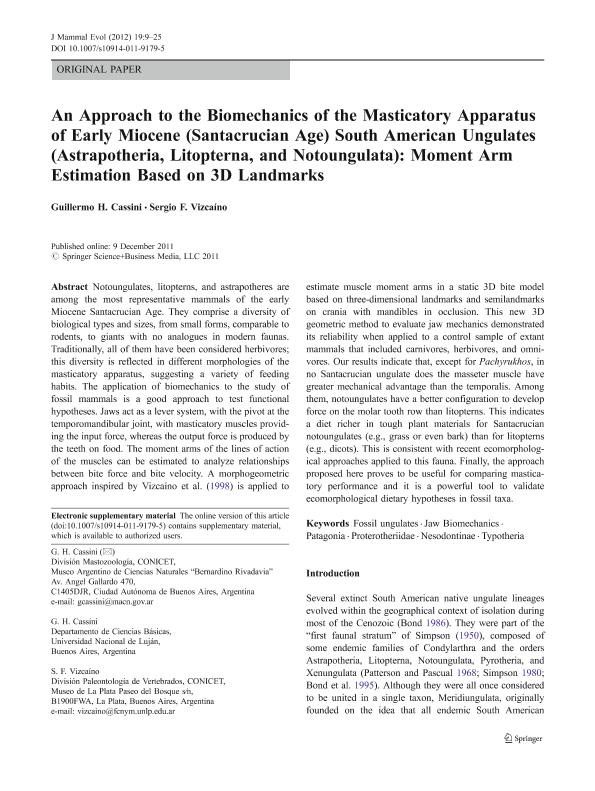Mostrar el registro sencillo del ítem
dc.contributor.author
Cassini, Guillermo Hernán

dc.contributor.author
Vizcaino, Sergio Fabian

dc.date.available
2017-06-12T15:28:27Z
dc.date.issued
2012-01
dc.identifier.citation
Cassini, Guillermo Hernán; Vizcaino, Sergio Fabian; An approach to the biomechanics of the masticatory apparatus of early Miocene (Santacrucian Age) South American ungulates (Astrapotheria, Litopterna, and Notoungulata): Moment arm estimation based on 3D landmarks; Springer; Journal Of Mammalian Evolution; 19; 1; 1-2012; 9-25
dc.identifier.issn
1064-7554
dc.identifier.uri
http://hdl.handle.net/11336/17970
dc.description.abstract
Notoungulates, litopterns, and astrapotheres are among the most representative mammals of the early Miocene Santacrucian Age. They comprise a diversity of biological types and sizes, from small forms, comparable to rodents, to giants with no analogues in modern faunas. Traditionally, all of them have been considered herbivores; this diversity is reflected in different morphologies of the masticatory apparatus, suggesting a variety of feeding habits. The application of biomechanics to the study of fossil mammals is a good approach to test functional hypothesis. Jaws act as a lever system, with the pivot at the temporomandibular joint, with masticatory muscles providing the input force, whereas the output force is produced by the teeth on food. The moment arms of the lines of action of the muscles can be estimated to analyze relationships between bite force and bite velocity. A morphogeometric approach inspired by Vizcaíno et al. (1998) is applied to estimate muscle moment arms in a static 3D bite model based on three-dimensional landmarks and semilandmarks on crania with mandibles in occlusion. This new 3D geometric method to evaluate jaw mechanics demonstrated its reliability when applied to a control sample of extant mammals that included carnivores, herbivores, and omnivores. Our results indicate that, except for Pachyrukhos, in no Santacrucian ungulate does the masseter muscle have greater mechanical advantage than the temporalis. Among them, notoungulates have a better configuration to develop force on the molar tooth row than litopterns. This indicates a diet richer in tough plant materials for Santacrucian notoungulates (e.g., grass or even bark) than for litopterns (e.g., dicots). This is consistent with recent ecomorphological approaches applied to this fauna. Finally, the approach proposed here proves to be useful for comparing masticatory performance and it is a powerful tool to validate ecomorphological dietary hypotheses in fossil taxa.
dc.format
application/pdf
dc.language.iso
eng
dc.publisher
Springer

dc.rights
info:eu-repo/semantics/openAccess
dc.rights.uri
https://creativecommons.org/licenses/by-nc-sa/2.5/ar/
dc.subject
Fossil Ungulates
dc.subject
Jaw Biomechanics
dc.subject
Patagonia
dc.subject
Proterotheriidae
dc.subject
Nesodontinae
dc.subject
Typotheria
dc.subject.classification
Biofísica

dc.subject.classification
Ciencias Biológicas

dc.subject.classification
CIENCIAS NATURALES Y EXACTAS

dc.subject.classification
Zoología, Ornitología, Entomología, Etología

dc.subject.classification
Ciencias Biológicas

dc.subject.classification
CIENCIAS NATURALES Y EXACTAS

dc.title
An approach to the biomechanics of the masticatory apparatus of early Miocene (Santacrucian Age) South American ungulates (Astrapotheria, Litopterna, and Notoungulata): Moment arm estimation based on 3D landmarks
dc.type
info:eu-repo/semantics/article
dc.type
info:ar-repo/semantics/artículo
dc.type
info:eu-repo/semantics/publishedVersion
dc.date.updated
2017-05-22T20:49:16Z
dc.journal.volume
19
dc.journal.number
1
dc.journal.pagination
9-25
dc.journal.pais
Alemania

dc.journal.ciudad
Berlin
dc.description.fil
Fil: Cassini, Guillermo Hernán. Universidad Nacional de Luján. Departamento de Ciencias Básicas; Argentina
dc.description.fil
Fil: Vizcaino, Sergio Fabian. Consejo Nacional de Investigaciones Científicas y Técnicas. Oficina de Coordinación Administrativa Parque Centenario. Museo Argentino de Ciencias Naturales "bernardino Rivadavia"; Argentina
dc.journal.title
Journal Of Mammalian Evolution

dc.relation.alternativeid
info:eu-repo/semantics/altIdentifier/url/https://link.springer.com/article/10.1007%2Fs10914-011-9179-5
dc.relation.alternativeid
info:eu-repo/semantics/altIdentifier/doi/http://dx.doi.org/10.1007/s10914-011-9179-5
Archivos asociados
